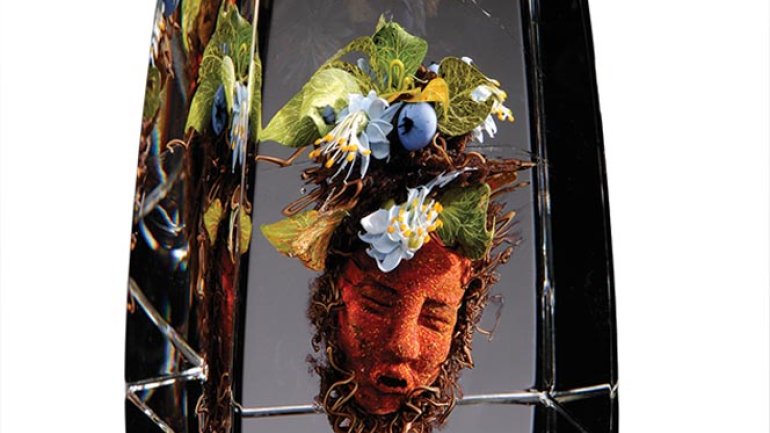Preternatural Worlds
Preternatural Worlds
Beauty Beyond Nature: The Glass Art of Paul Stankard
Paul Stankard’s glass works explore the beauty of the natural world through his use of flame, torch, glass rods, and no small amount of technical prowess. One of the premier practitioners of the paperweight genre, Stankard makes traditional glass forms of botanical beauty that effortlessly bridge the divide between kitsch and contemporary art.
“Beauty Beyond Nature” at the Museum of Glass in Tacoma opens with the alembics and valves that Stankard created during his time as a maker of laboratory glassware. These finely honed instruments, however, soon give way to fantastical rendering of nature at the edge of reality. Popular with both contemporary and antique paperweight collectors, his glasswork recalls 19th-century botanical drawings, cabinets of curiosities, and a time when the sciences and the arts were nearly indistinguishable from one another.
In straightforward constructions such as the Summer Field Arrangement paperweight (1978), brilliantly hued and realistically rendered wildflowers are prettily gathered in a bouquet-ready configuration that does not demand further reflection. By 1980, however, Stankard had developed a system of fusing glass in order to create distinct, layered scenes. Doing so substantially expanded his visual lexicon and allowed him to construct small-scale dramas set within the natural world. In the Winter Squash paperweight (2000), curling tendrils and squash flowers are visible on top, while tiny, seemingly weightless human bodies are literally embedded in the roots below. Stankard’s topsy-turvy take on existence suggests a parallel between plant life and humankind that is repeated in works such as the Pineland Pickerel Weed with Honeybee paperweight (2007), in which figures hang suspended below dazzling yellow flowers and a striped globular bee. In almost imperceptible text Stankard has included the word “fertile” on a vertical stem, a theme given more complete form in the Four Seasons cloistered assemblage (2008). In this rectangular composition, the seasons are represented by a floral arrangement, below which groups of entangled humans writhe, give birth, dance, and eventually succumb.
During the Enlightenment, the idea that Earth contained secret hidden spheres below its surface gained credibility, especially when backed by well-respected scientists like Edmond Halley of Halley’s Comet fame. Stankard, too, suggests worlds inside worlds to evoke the mystery-laden cycles inherent in nature.
The 168-page exhibition catalog, published by the Robert M. Minkoff Foundation, pays tribute as much to Stankard’s technical ability as to the beauty that is its result. With detailed black-and-white photographs of the artist’s tools and workspace, and 98 color plates of his work, the book underscores Stankard’s remarkable ability to craft compelling illusions from man-made tools.
Stankard was named to the American Craft Council College of Fellows in 2000, an acknowledgment of his mastery of glass, which captivates in the same way that a novel written on a grain of rice or a ship in a bottle does. But it’s his understanding of humanity’s place in and among nature that takes his work from the realms of the merely decorative and into the brilliantly hued heart of the fire.
Suzanne Beal is a writer in Seattle.
Beauty Beyond Nature: The Glass Art of Paul Stankard
Museum of Glass
Tacoma, Washington
November 12, 2011 – June 17, 2012

